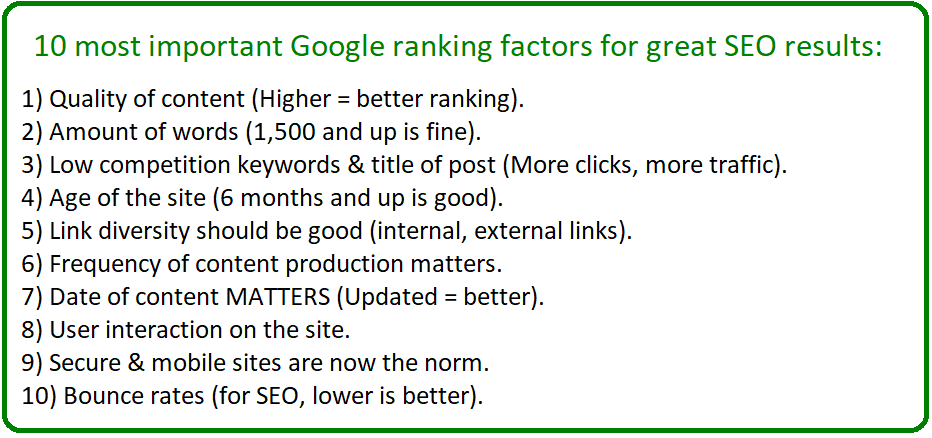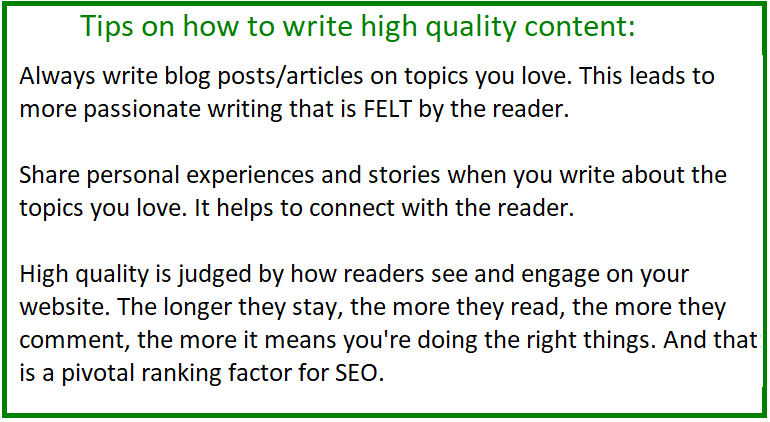There are 100’s of ranking factors that affect SEO on Google, but the 10 I’ll give you in this checklist are most important. They work 100%.
I’ve updated these 10 ranking factors for 2019 (and will for every subsequent year, meaning this post WILL be updated) and here is the list (details on each will be mentioned under it):

Now I will detail each one and WHY it is important for SEO success. Now if you are experienced in being able to understand how to implement these 10 factors, go for it but if you’re new, and understand what I’m saying, but will have trouble implementing them, then…
At the end of this article, I’ll provide a resource to help you with that.
Contents
1) Quality of content (Higher = better).
Since I began studying and learning SEO trends, one thing that has consistently been paramount and ever more important as SEO evolves is content. Specifically, these 3 things:
- The content you write.
- The images you put up alongside the content you write.
- The videos you create and put on your website, also alongside the content and images.
Now I usually focus my energy on writing good content and putting up images only, but once in awhile, to help boost my site’s ranking and get myself a good backlink, I’ll create a YouTube video, and link it back to my site and that helps a lot too.
I strongly believe that out of all the ranking factors, the most consistent and possibly most important one is writing high quality content. If you have questions about how to write this yourself, on your site, ask me below, and give me a specific example you can use.

2) The amount of words matters. 1,500 words per page is a good quota.
Typically high quality content is accompanied by a lot of it, and what I mean by that is, a lot of words. Generally, the more descriptively you write content, the better it’ll be in it’s quality and the longer it’ll also be in it’s wording.
It is important though that you not prioritize word count over quality, because after all, your goal with writing good quality content is to get people who read it, to love it and that experience and engagement they have in doing so, to be seen by Google.
I’ve made the mistake of prioritizing word count over quality more than once, and EVERY TIME, it’s resulted in low rankings for those posts. It’s not like writing 1,500 words = better rankings, no.
Quality is what is TRULY the most important factor here and what I do find is that most high ranking websites and their pages have both quality and well over 1,500 words.
In other words, for the word count to matter, it has to be mixed with quality to work for SEO.
The same tips I have above for high quality content writing will help you write MORE of it, so apply the same tips for this second and very important ranking factor.
3) Low competition keywords matter, as do your page titles.
Low competition keywords can be found very easily and there’s really an infinite amount of them, but what is equally as important is how you use these keywords in your page/blog post titles.
The reason it’s important is that once you publish a post and let Google find it (or manually use the URL inspection tool to get it indexed faster), Google will “throw” your article around it’s search engine for the keyword you listed, and see how people interact with it.
By interaction, it means they are going to let it pop up for the specific keyword you targeted and see if people click on, and if they do, in what amounts, followed by how they interact with the page itself and it’s content.
The goal is to make a good impression with your title WHILE targeting the low competition keyword and get more clicks (because it will lead to better rankings), which is why both these elements NEED to be mixed together. Here are tips on this.
When I learned about the importance of this ranking factor, I went through my older/existing websites and updated many of the titles I thought were boring. You should do this too.
4) A mature site (6 months or older) is itself a ranking factor.
Throughout this website, I’ve talked about an important “filtering” system Google has in place called the sandbox and that it uses this sandbox on new sites (by new sites, I mean their age), purposely keeping the content they put out within the lowest rankings possible, for up to 6 months in order to make the site owner earn Google’s trust.
With every new website I have created, I have known in advance about the sandbox and that I should expect to NOT see very high rankings until several months into the process, as the site ages further.
But I also understood (and explain in the sandbox link I placed just now) that I couldn’t just wait for that maturity to hit, because just like I said about quality content and word count above, your goal during the sandbox IS to grow the site and show Google that you’re worthy of being “released” from the sandbox zone.
So while the sandbox WILL happen to your site when it’s new in age, ignore it, build up your content base, make it high quality and it will disappear on it’s own, and you WILL see this as more organic traffic will flood your website.
Another thing you WILL see while in the sandbox is a high fluctuation of the Google dance. Ignore that too and carry on with the tips I just said for the sandbox.
5) Link diversity is a very important ranking factor.
There are generally 3 different types of links you can put on your website. You can have…
- Internal links lead to other pages within your site. These carry the biggest SEO weight.
- External links lead to third party pages outside your site. These also have a positive SEO weight.
- Affiliate links also lead to third party pages outside your site too. These are either neutral or weigh down your rankings.
Healthy link diversity on a page means you have the above 3 types of links present. I have noticed enough times how rankings are affected when I don’t do enough of this. For example…
- If I have a page that has nothing but affiliate links, in just about 100% of cases, that post will NOT rank high on Google.
- If I have a page that has a few internal or external links (let’s say 2 for a 1,000 word article), it will also not do well.
- But if I have a lot of internal links, some external links on a single page, that one will generally do pretty well.
- Even if you have a page with affiliate links, include internal and external links on the page too to balance out the link diversity.
6) Content production frequency matters.
Google takes note of how often you publish new articles on a website, because the more you do this, the more it’ll crawl your site and reward you for it. I have a whole article here dedicated to explaining how often you should post content in order to do well with SEO.
7) The date of your content matters.
I have only recently started implementing this tip and it is HUGE. What I have found is that when I update an old article, it’s content and the DATE to a more current period, then tell Google to inspect it, it WILL rank higher.
I have in the past optimized my blog posts, but not edited the date to be more present and this has resulted in little or no upward move in positions.
The thing is, Google loves to give rewards to more updated sites, and if yours has posts that are several years old, and there’s new websites coming out with similar content yours has, but they are more updated with their dates, they will generally get better positions.
To combat this, just optimize your page and then update it’s date, so Google will know that yours is better. The date of your blog posts is 100% a ranking factor and a VERY important one too.
8) User interaction on the site matters.
This is a simple thing to understand, but if your site has nothing worth reading or checking out, then people won’t stay around for long. If they do, it’ll have the opposite (good) effect. Your goal is to get people to read and interact with your site better and you can do that by implementing these tips:

9) Secure sites and mobile sites are a must.
If there’s anything official that Google has indeed said affects ranking, it’s these 2 things, but I included them into tip 9 because they can easily be implemented.
For secure sites and their importance, here is a blog post from Google to show proof it’s real.
For mobile sites, here is a blog post from them as well explaining how it’ll be counted towards websites.
10) Bounce rates count.
Basically bounce rates are a reflection of the interaction people have on your website, but in numbers (factor #8 on this list). The lower it is, the more it means people navigate from within your site and digest your content better (I’d say under 60% is good).
This leads to better positioning, so the tip I have for you is to do the same stuff I said in #8.
2 ways to make sure you have these 10 factors checked off:
1) The first is to read this checklist I’ve provided on improving positioning, as all important factors I’ve covered here are covered in the bullet points in that article. Complete those things and you WILL have these 10 things down too.
2) The second is that if any of the stuff I’ve mentioned here leaves you lost, then this is what’ll make sure that doesn’t happen:

Now that I’ve listed the 10 most important factors, I’d LOVE to know your thoughts on them and if you think there’s more that need to be included in the checklist above.
I’ve also structured these 10 things in way which makes them “connected” and the truth is, the core of SEO success is like that in reality.